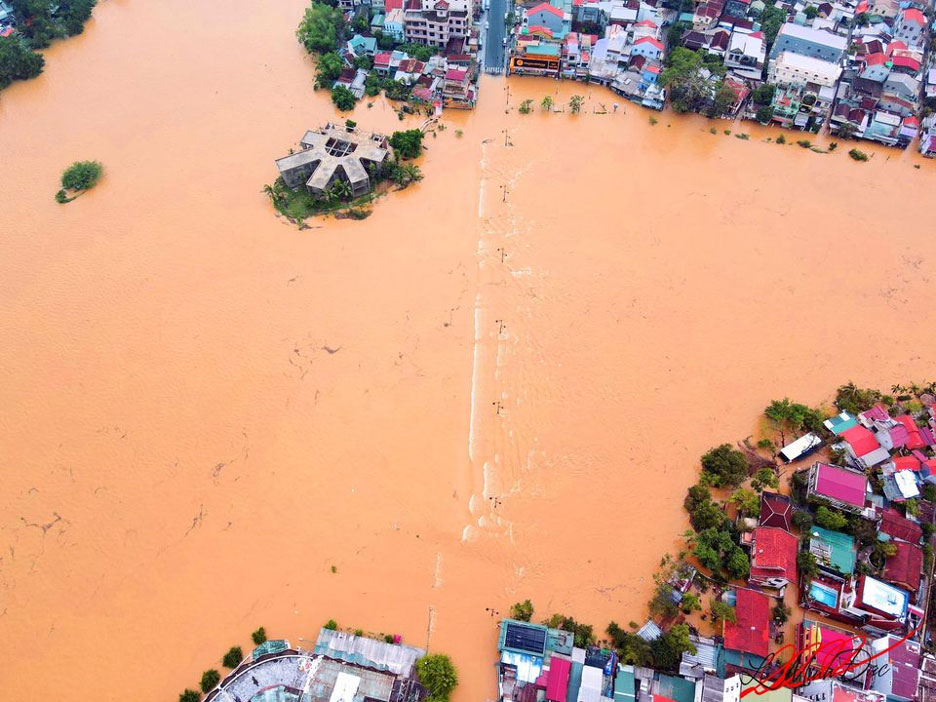Image © WWF-Viet Nam / Khanh Ton.
Climate risks in the Central Annamites
The mountainous Central Annamite landscape in central Vietnam and southern Laos contains one of the largest connected areas of natural forest in mainland Southeast Asia. These evergreen forests are home to rare and unique wildlife, including 134 mammal species and over 500 species of birds, but biodiversity is declining as a result of illegal logging, hunting, habitat degradation and climate change. Within this landscape, around 7 million people rely on forests and agriculture for their livelihoods. Although Vietnam’s economy has grown at a staggering rate over the last two decades, rural poverty rates remain high, particularly among ethnic minority communities.
As in ever more corners of the world, central Vietnam is seeing increased negative climate impacts. In 2020, the area experienced historic storms, floods, and landslides that caused a great amount of damage to farms and villages. Although 2020 was particularly severe, such events are common, and appear to be increasing in frequency and severity. Climate risks are exacerbated by unsustainable land use practices including deforestation, industrial large-scale timber plantations, agriculture expansion, and monoculture coffee.

Non-timber forest products for local livelihoods
For sustainable development in the region, it will be necessary to identify and support supply chains that can improve local livelihoods while increasing climate resilience and protecting the natural environment. Non-timber forest products such as bamboo, seeds, fruits, and nuts show great potential, as they allow communities to get economic value from the forest without cutting down trees. They can also contribute to increased climate resilience for farmers by providing alternative sources of income and reducing reliance on one crop. In addition to well-known plants like bamboo and rattan, the forests of central Vietnam contain many other non-timber forest products that can be sustainably collected and sold, including black locust seeds for traditional shampoos, soap nuts for natural cleaning products, and tung oil seeds for wood coatings.

Landscape Resilience Fund supports community reforestation
The Landscape Resilience Fund (LRF) supports climate-resilient enterprises, but also supports sustainable supply chain development more broadly in its active landscapes. In the Central Annamites, non-timber forest products have been identified by WWF as a key sector to increase climate resilience for farmers. To increase the supply of raw materials, and improve livelihoods while contributing to forest restoration, the LRF is supporting WWF to work with local communities on a tree planting pilot.
The project is taking place in Trang Ta Puong village in the province of Quang Tri, home to 78 households from the Bru-Van Kieu ethnic minority. The Bru-Van Kieu are one of three ethnic minority groups living in the mountainous areas of Quang Tri, and suffer from high levels of poverty, limited access to finance and technical support for their farms, and worsening climate impacts.
Starting in June 2023, WWF-Viet Nam consulted with village members about the challenges they faced, and possible solutions, including which trees they would like to plant. WWF also discussed with local businesses to confirm market demand for the different forest products.


The farmers chose to plant black locust seed and soap nut trees, which are native species already growing in the forest and well-known to them, and to experiment with lemon trees for essential oil, a new species for them. These trees will provide additional income for farmers, with lemons being produced after only 18 months, and black locust tree and soap nuts taking up to 8 years. Farmers also planted chinaberry and yellow cheesewood, two species of native tree that can be used for timber, for house construction. These grow relatively slowly, but should reduce future deforestation pressure by providing a source of wood, and as native species they support local biodiversity, and are adapted to local conditions making them more resilient. Tree-planting should help reduce landslides and flooding, by absorbing rainfall and stabilising soils.

Planting took place in October and November 2023, with WWF providing seedlings, inputs such as organic fertilisers, and technical training to local communities. For this pilot project, 24 households planted seedlings on 6 hectares of their farmland, and on 6 hectares of community-managed forest. Community members were trained on how to manage the trees as they grow, and to monitor and report on progress. The WWF team will also make regular site visits, to check on the trees, and see what factors contribute to the best growth rates. As of April 2024, seedlings are growing well, and LRF is planning to expand the pilot.

Based on the most promising techniques, WWF will develop and share guidelines for how to implement this reforestation approach, so that other communities, NGOs, or local government can replicate and scale this pilot. This site will be used as a demonstration model, to show the potential of tree planting to other farmers and encouraging forest restoration across the landscape.
Connecting forest product collectors with buyers
As well as working with the communities that rely on forest products, LRF is also supporting WWF’s work with small businesses that buy these raw materials and turn them into useful products. These enterprises play an important role in adding value and in connecting rural local communities with urban and international markets. Following discussion with WWF, one business has already agreed to buy the lemons produced by the planting pilot.
By working with forest product collectors, buyers, and other stakeholders as part of an integrated landscape approach, LRF and WWF will support sustainable supply chains that can increase climate resilience for vulnerable people, and benefit biodiversity across this important landscape.
The LRF’s landscape approach to building climate resilience unlocks positive benefits for biodiversity and gender equity. Investors and philanthropic funders interested in supporting this work can contact the Landscape Resilience Fund today to find out more.
